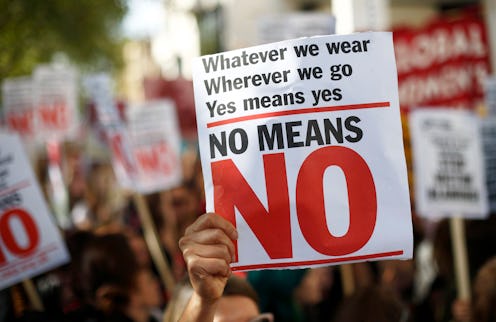News
What Campus Sexual Assault Stats Really Look Like
By now, you've either read Rolling Stone's bombshell exposé on a UVA fraternity's alleged sexual assault or heard about the controversy around it. The story itself, like countless others detailing sexual assault, is disturbing and harrowing, but perhaps even more sobering than the personal accounts are the cold, hard statistics of sexual assault on college campuses. If the now-discredited details of Rolling Stone story left anyone unconvinced that sexual assault is prevalent on campuses, then they should take a look at these stats. Because you can't argue with numbers.
With the help of investigative pieces like the ones from the Center of Public Integrity's project "Sexual Assault on Campus: A Frustrating Search For Justice," the Obama administration took action in 2014 to combat this issue. On Jan. 22, 2014, President Obama launched a White House task force to compile a comprehensive report titled "Not Alone," aimed at helping to prevent students from sexual assault.
The White House report's statistics, along with other statistics compiled by organizations such as the ACLU, tell a nightmarish story of its own. If you found Jackie's account — regardless of how many details did or did not turn out to be entirely accurate — to be disturbing, then these stats should be even more so, because they indicate many of those stories are potentially happening on campuses across the country right now. Take a look at these very sobering numbers.
The White House's Statistics
In announcing the task force, Obama stated:
Sexual violence is more than just a crime against individuals. It threatens our families, it threatens our communities; ultimately, it threatens the entire country. It tears apart the fabric of our communities. And that’s why we’re here today — because we have the power to do something about it as a government, as a nation. We have the capacity to stop sexual assault, support those who have survived it, and bring perpetrators to justice.
- One in five women is sexually assaulted while attending college.
- The assault will most likely take place during her freshman or sophomore year.
- In 75 to 80 percent of the cases, the victim knows her attacker — he's usually an ex-boyfriend, friend, classmate, or acquaintance.
- Many of the victims experience "incapacitated assault," where the target is sexually abused while drunk, drugged, passed out, or otherwise incapacitated.
- Only 2 percent of incapacitated survivors and 13 forcible rape survivors report their assault.
- 40 percent of victims fear retribution from the accused, and therefore don't report their assault.
The ACLU and Students Active For Ending Rape's (SAFER) Statistics
In 2010, the ACLU cited a staggering figure from a Feministing report: 95 percent of campus rapes go unreported. The ACLU's Women's Rights Project also partnered with SAFER for a Campus Accountability Project, which compiled stats on the deficiencies in existing university policies for reporting rape.
- Less than 1 in 5 policies included amnesty clauses that protected underage survivors who were drugged or intoxicated at the time of the assault.
- Less than 1 in 3 policies stated that a survivor's attire and past sexual history is prohibited from being discussed during the disciplinary proceedings.
- Less than one-third of the policies stated how students can raise concerns or change the existing policies.
Rape, Abuse, and Incest National Network's (RAINN) Statistics
RAINN cites studies conducted by the National Institute of Justice (NIJ) and the Department of Justice, noting that the 5 percent of reported campus assaults is far fewer than the overall number of rapes reported by the general population, which is about 40 percent. Other statistics include:
- According to the NIJ's 2000 study, 80 to 90 percent of rape survivors knew their assailants (a higher percentage than the White House's more recent figures), emphasizing that the more intimate the relationship, the more likely for the rape to occur.
- The NIJ also reported that about 13 percent of women experience at least one stalking incident during their college years.
- Citing a 2005 NIJ study on universities' sexual assault response policies, RAINN notes that only 40 percent of schools offered any sexual assault training.
- Less than 40 percent of schools trained security personnel to deal with sexual assault.
- Of the schools that offered sexual assault education programs, less than one-third included acquaintance assault prevention in their programs.
Images: Getty Images (3)
